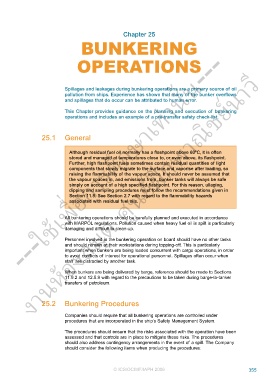Page 389 - International safety guide for oil tankers and terminals
P. 389
Chapter 25
---ใช้เพื่อการศึกษาเท่านั้น---
BUNKERING
This Chapter provides guidance on the planning and execution of bunkering์นาวี
OPERATIONS
Spillages and leakages during bunkering operations are a primary source of oil
งานห้องสมุด ศูนย์ฝกพาณิชย
pollution from ships. Experience has shown that many of the bunker overflows
and spillages that do occur can be attributed to human error.
operations and includes an example of a pre-transfer safety check-list.
25.1 General
Although residual fuel oil normally has a flashpoint above 60ºC, it is often
stored and managed at temperatures close to, or even above, its flashpoint.
Further, high flashpoint fuels sometimes contain residual quantities of light
ึ
components that slowly migrate to the surface and vaporise after loading, so
raising the flammability of the vapour space. It should never be assumed that
the vapour spaces in, and emissions from, bunker tanks will always be safe
simply on account of a high specified flashpoint. For this reason, ullaging,
dipping and sampling procedures must follow the recommendations given in
Section 11.8. See Section 2.7 with regard to the flammability hazards
associated with residual fuel oils.
All bunkering operations should be carefully planned and executed in accordance
with MARPOL regulations. Pollution caused when heavy fuel oil is spilt is particularly
damaging and difficult to clean-up.
Personnel involved in the bunkering operation on board should have no other tasks
and should remain at their workstations during topping-off. This is particularly
important when bunkers are being loaded concurrent with cargo operations, in order
to avoid conflicts of interest for operational personnel. Spillages often occur when
staff are distracted by another task.
When bunkers are being delivered by barge, reference should be made to Sections
11.9.2 and 12.5.9 with regard to the precautions to be taken during barge-to-tanker
transfers of petroleum.
25.2 Bunkering Procedures
Companies should require that all bunkering operations are controlled under
procedures that are incorporated in the ship’s Safety Management System.
The procedures should ensure that the risks associated with the operation have been
assessed and that controls are in place to mitigate these risks. The procedures
should also address contingency arrangements in the event of a spill. The Company
should consider the following items when producing the procedures:
© ICS/OCIMF/IAPH 2006 355

